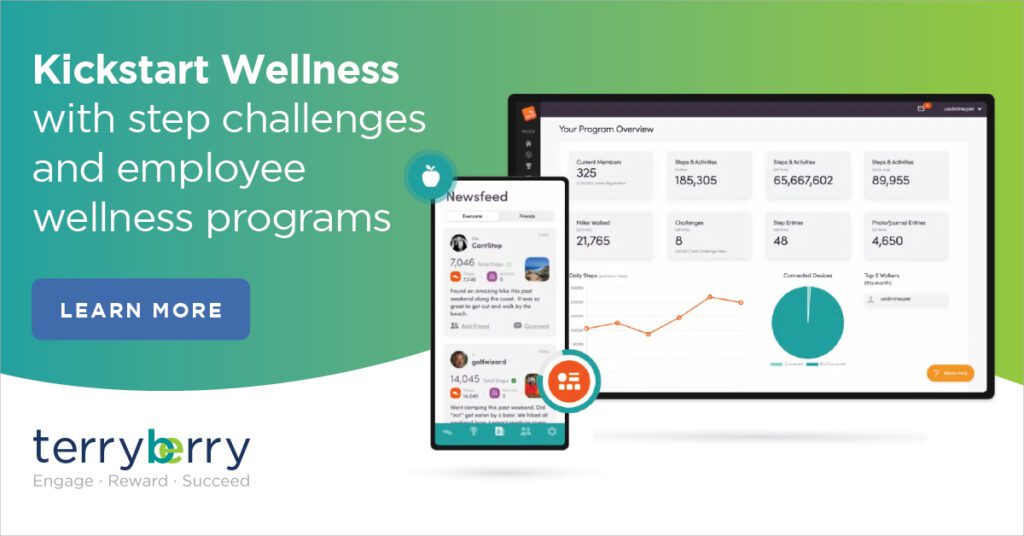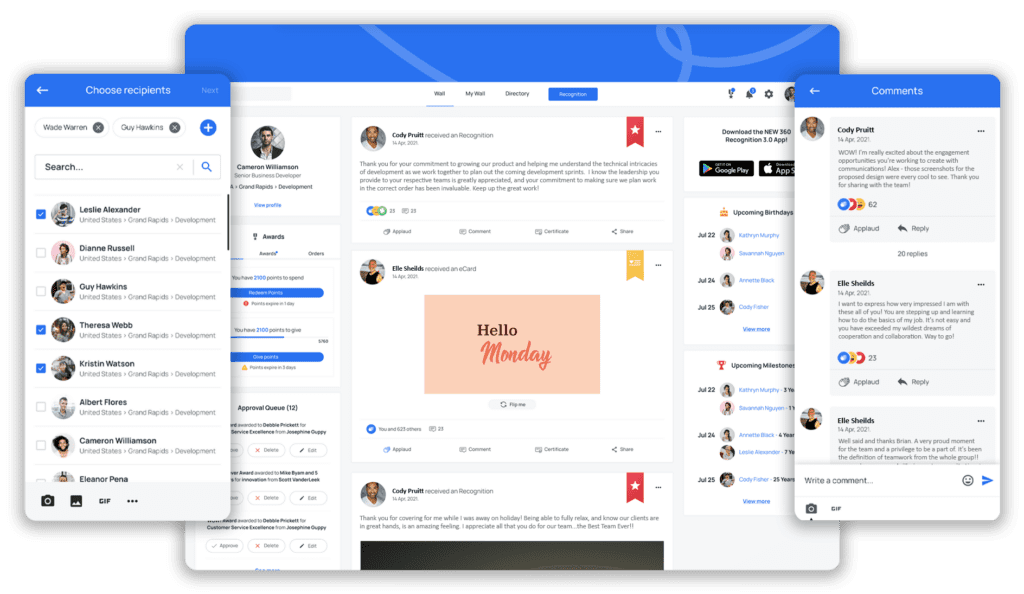December 20, 2023

After the Pandemic and subsequent Great Resignation, we may have finally turned the curve on employee retention.
New research shows that job satisfaction is actually the highest it’s been since 1987. From a low of 43% during the Great Recession, job satisfaction is now up to 62% in 2023. Consequently, retention rates are also up - a poll from B2B Reviews found 70% of employees aren’t currently looking for a new job.
But what's driving this shift? And how can companies continue to improve employee retention and job satisfaction?
Here, we'll take a look at what strategies are working and how you can improve both employee satisfaction and retention at your company.
What is Employee Satisfaction and retention?
Employee satisfaction and retention are two interconnected concepts that relate to the well-being, engagement, and longevity of employees within an organization.
Employee Satisfaction:
Employee satisfaction refers to the contentment, happiness, and fulfillment that employees experience in their roles and within the organization.
It encompasses various aspects of the work environment, including job responsibilities, work culture, relationships with colleagues, opportunities for growth, compensation, and overall job conditions. High levels of employee satisfaction are often associated with increased productivity, motivation, and a positive work atmosphere.
Key factors influencing employee satisfaction may include:
- Job Content: The nature of the work and the alignment with an employee's skills and interests.
- Work Environment: The culture, values, and atmosphere within the organization.
- Compensation and Benefits: Fair and competitive pay, along with other perks and benefits.
- Career Development: Opportunities for training, skill development, and career advancement.
- Healthy Work-Life Balance: The balance between work and personal life.
Employee Retention:
Employee retention strategies involve the efforts an organization makes to keep its talented and skilled workforce intact for an extended period.
High employee retention is desirable for several reasons, including the cost savings associated with recruiting and training new employees, the preservation of institutional knowledge, and the maintenance of a stable and experienced team.
Strategies for employee retention may include:
- Effective Leadership: Leadership that inspires, motivates, and supports employees.
- Recognition and Rewards: Acknowledging and rewarding employees for their contributions.
- Professional Development: Providing opportunities for learning and career growth.
- Workplace Flexibility: Offering flexible work arrangements that cater to individual needs.
- Competitive Compensation: Ensuring that salaries and benefits are competitive in the market.
Organizations that prioritize employee satisfaction tend to reduce turnover rates, as satisfied employees are more likely to stay with the company.
Conversely, low employee satisfaction can lead to increased turnover, which can be costly and disruptive for an organization. Therefore, businesses often implement strategies to enhance both satisfaction and retention as part of their efforts to improve the employee experience.

Benefits of Prioritizing Employee Satisfaction
Prioritizing employee job satisfaction is a priority at most organizations today. Doing so can yield countless benefits for both employees and the organization as a whole. Here are some key advantages:
Higher Retention Rates:
When employees are satisfied with their jobs, workplace culture, and overall experience, they are more likely to stay with the company for a longer period. This can reduce employee turnover rates, saving the organization recruitment and training costs.
Increased Productivity:
When employees are satisfied at work, they're generally more engaged and motivated. They are likely to be more productive, take initiative, and contribute positively to the overall output of the organization.
Improved Morale:
A positive and satisfying work environment contributes to higher employee morale. When employees feel valued and supported, they are more likely to have a positive attitude, leading to a better overall atmosphere in the workplace.

Enhanced Employee Engagement:
Employee job satisfaction is closely linked to employee engagement levels. Engaged employees are emotionally committed to their work, leading to increased effort, creativity, and a willingness to go above and beyond in their roles.
Better Teamwork and Collaboration:
When employees are satisfied, they're more likely to collaborate effectively with their colleagues. A positive work environment fosters teamwork, communication, and a sense of camaraderie among employees, contributing to a more cohesive and productive team.
Attracting Top Talent:
Organizations known for prioritizing employee satisfaction are often more attractive to potential hires. A positive employer reputation can help in attracting and retaining top talent in the job market.
Reduced Absenteeism:
When employees are satisfied, they're less likely to take unnecessary time off work. A positive work environment and supportive policies contribute to better attendance and punctuality.
Enhanced Customer Satisfaction:
Satisfied and engaged employees are more likely to provide better customer service. Happy employees tend to be more customer-focused, leading to improved relationships with clients and customers.
Innovation and Creativity:
Employee satisfaction can foster a culture of innovation and creativity. Employees who are satisfied at work feel comfortable expressing their ideas and are more likely to contribute to the development of new and innovative solutions.
Positive Company Culture:
Prioritizing employee satisfaction contributes to the development of a positive company culture. This, in turn, can attract like-minded individuals and create a workplace where employees feel a sense of belonging and shared values.
Overall, prioritizing an employee's satisfaction is not only a moral imperative but also a strategic business decision that can positively impact various aspects of organizational performance and success.

Employee Retention Strategies
Effective employee retention strategies are crucial for organizations to retain their top talent and create a stable, motivated, and productive workforce. But ultimately, to increase retention, companies need to improve employee satisfaction.
Here are some important factors to consider when improving employee retention and satisfaction:
Competitive Compensation and Benefits:
It may be taboo to talk about pay, but it's an unavoidable aspect of job retention. In fact, a poll by BCW found that 35% of people say annual salary is the most important factor in staying at their company.
While it may not be the majority overall, the majority of younger workers — 59% of millennials and 53% of Gen Z-ers — say they want more money than they’re currently making.
At the same time, more than half (52%) said they haven’t received a pay increase in the last year.
Conversely, 48% of Baby Boomers said the primary reason to stay at a company was insurance coverage.
So, one way to increase employee satisfaction and retention is to ensure that your organization offers competitive salaries and benefits packages. Be sure to regularly review and adjust compensation to align with industry standards and employee expectations.

Professional Development Opportunities:
Another crucial factor for employee satisfaction is having career development and professional growth opportunities. So much so, one poll found that 72% of employees leave jobs if they felt their skills were underutilized or if they felt under stimulated.
Meaning, people want meaningful work today as well as development opportunities for what they’ll do tomorrow. In a B2B Reviews poll, 15% of people stayed for career growth and 12% for leading and development opportunities.
Part of this involves providing employees with a clear understanding of potential career paths within the organization. Then, offer guidance on how they can progress in their roles and advance in their careers.
Additionally, provide opportunities for talent development and career advancement and encourage employees to take part in them. Support employees in their efforts to enhance their skills and progress within the organization.
Recognition and Rewards:
One thing is true for just about everyone regardless of their position - people want to feel appreciated. And that's where employee recognition programs come in.
Effective employee recognition is linked to increased employee retention, morale, and job engagement. So much so, research from Forbes has found that companies scoring in the top 20% for their culture of recognition had turnover rates 31% lower.
However, many companies today are still missing the mark here, ultimately contributing to employee dissatisfaction. According to a Gallup poll, only one in three employees were recognized for their work in the last 7 days.
Another report found that employees had averaged 50 days since they were last recognized. This means, although recognition programs work, they're not being used enough.
So, companies should prioritize employee recognition. Recognize and reward employees for their achievements and contributions. This can include formal recognition programs, employee of the month awards, or other incentives to show appreciation.
Or try an online employee recognition software, like Terryberry's Be Recognized platform. This allows recognition to happen in real time through a social feed, and empowers employees by supporting peer-to-peer recognition. Infuse purpose back into employees’ work by acknowledging their efforts and showing them how they’re a part of a bigger mission.
RELATED: How to Build an Effective Employee Recognition Program
Flexible Work Arrangements:
Work-life balance is arguably more important now than ever. After the pandemic, employees and leaders alike learned that working from home can be a win/win.
According to research by Forbes, 91% of people feel they have a better work-life balance working from home. Followed by 79% being more productive, 78% are less stressed, and 78% enjoy avoiding a commute - all important factors for employee satisfaction.
So consider offering flexible work options, such as remote work, flexible hours, or try your hand at the 4-day work week. This helps employees achieve a better work-life balance, contributing to job satisfaction.
Effective Leadership and Management:
We've all heard the saying, "People don't quit jobs, they quit managers." While this may not always be the case, it is true often. So avoid creating employee dissatisfaction by ensuring your leaders are effective.
Part of this includes open lines of communication, like regular feedback, stay interviews, and employee engagement surveys.
Regularly provide feedback on performance and create a culture where employees can feel comfortable expressing their concerns or ideas.
Prevent exit interviews by conducting stay interviews. Gain an understanding of the reasons why employees stay and uncover potential reasons for leaving. Use the feedback to identify areas for improvement and make necessary adjustments to retain talent.
Consider starting an employee survey strategy, as well. Surveys are a great way to measure employee engagement as well as how employees might feel about their work, their job satisfaction, and their commitment to the organization.
An employee engagement survey solution, like Terryberry's Be Heard platform, provides an easy-to-use solution for both employee engagement and pulse surveys.
Utilize these surveys to gain deeper insights about:
- Job satisfaction
- Employee engagement with work
- Commitment to the organization
- Motivation at work
- Satisfaction with management
Also, ensure that leaders and managers are skilled in people management. Effective leadership that communicates well, supports employees, and provides constructive feedback will positively impact retention.

Workplace Well-Being Initiatives:
Employee wellbeing refers to the physical, mental, and emotional health, satisfaction, and overall quality of life of an organization's employees. It encompasses a wide range of factors that contribute to an an organization or individual's overall sense of happiness and contentment within their work environment.
A Harvard Wellness Program Meta Study found that for every dollar that’s spent on an employee well-being program, a company saves $3.27 due to reduced healthcare costs.
One reason for this is that when companies prioritize employee well-being, it helps employees become more aware of their physical and mental well-being. This can encourage employees to make healthier choices throughout their lives resulting in better health outcomes overall.
Additionally, when well-being initiatives are done well, they contribute to an overall healthy culture. And culture is important. So much so, one study found that a healthy company culture is 10 times more important to employees than pay.
So, prioritize employee well-being by offering comprehensive wellness programs, like Terrybery's Be Well platform. Be Well supports multiple aspects of employee mental well-being to physical to emotional wellness.
RELATED: 27+ Employee Wellbeing Initiatives to Support Your Workforce
Workplace Diversity and Inclusion:
DEI's importance is clear from a moral perspective - everyone deserves fair treatment and opportunity in the workplace, regardless of background, identity, or upbringing. So, focusing on DEI simply makes the world a better place, and that's a cause worth fighting for (or, at the very least, investing in).
However, workplace DEI initiatives serve a purpose beyond the moral compass. They're not just a human solution — they also drive better business outcomes.
So much so, 76% of job seekers consider workplace diversity an important factor when evaluating companies and job offers. And companies that champion diversity often see a staggering 2.5x increase in cash flow for every employee.
Additionally, teams that prioritize inclusivity consistently outperform their counterparts, boasting a 35% boost in productivity.
Just remember that prioritizing DEI in the workplace can't be a half-hearted job, otherwise it will come across as insincere. So, be sure that your initiatives align with your company values and get leadership buy-in from the get-go. Then, track how well your initiatives are going in your engagement surveys.

Conclusion
By implementing a combination of these employee retention strategies, organizations can create an environment where employees feel valued, supported, and motivated to stay and contribute to the company's success over the long term.
Next Steps
The Terryberry Be Engaged Platform offers a comprehensive solution that can host your employee engagement efforts, including milestone and service awards, peer-to-peer social recognition, feedback and communication, and performance and incentive rewards.
- Pulse Survey Software: Be Heard is an employee survey solution that's designed to enhance your employee experience while fueling business performance.
- Service Awards and Performance Awards: Recognize and reward employees based on years of service awards, anniversaries, or performance.
- Social Recognition: Empower your employees and managers to recognize their peers and celebrate successes with an easy-to-use social recognition application.
- Feedback and Communication: Unlock improved feedback and communications with employee and customer feedback solutions.
- Wellness Programs: We make it easy to run wellness programs and activity challenges that increase engagement, expand corporate health, and build team camaraderie.
Contact Us
Ready to learn more? Schedule a demo with our team to get a hands-on walkthrough of how Terryberry can transform the culture of your workplace.

